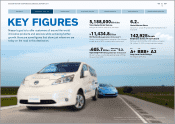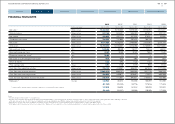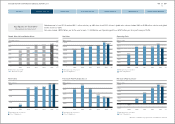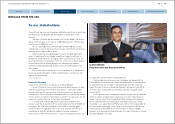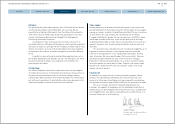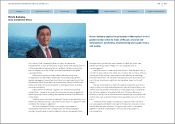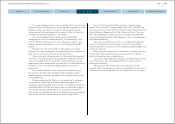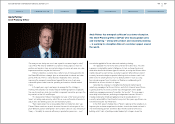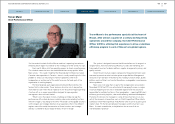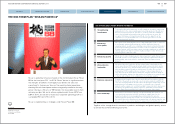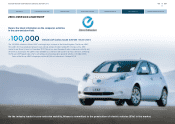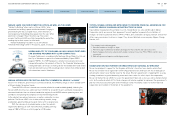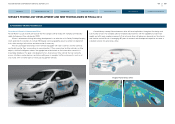Nissan 2014 Annual Report Download - page 13
Download and view the complete annual report
Please find page 13 of the 2014 Nissan annual report below. You can navigate through the pages in the report by either clicking on the pages listed below, or by using the keyword search tool below to find specific information within the annual report.
Andy Palmer
Chief Planning Officer
“For every car we design we must have a specific customer target in mind,”
says CPLO. “We have to embed the customer in every project: in how we
position our brands, in how we use technology, in how we enhance our sales
experience and how we plan for the future.”
Palmer’s relentless customer focus reflects two of the key priorities for
the Power 88 mid-term strategic plan: to enhance both the brand and sales
power of Nissan. There is a clear business imperative to his work. By
improving the company’s overall brand appeal, Nissan aims to enhance
transaction prices, lower incentive spending and continue to build market
share.
In the past year, signs have begun to emerge that the strategy is
working. The company has sharply reduced marketing expenses, especially
the use of incentives, which has resulted in improved transaction pricing in the
key markets of the U.S. and Europe.
This improvement follows the adoption last year of the “revenue control-
tower”, a tracking mechanism by which Nissan uses mathematical formula to
adjust sales & marketing costs, mix and transaction prices.
“Each improvement has a measurable effect on the bottom line,” says
Palmer. Palmer continues to push for more. He sees his role as part of “the
pivot” between product development and customer sales, he says monozukuri
theory − the ability to maximize efficiency in production processes − must
now also be applied to Nissan sales and marketing strategy.
This approach has led to five areas of brand and sales focus. First, the
company is using better market intelligence to track customer trends and
determine demand for different types of vehicles, ensuring that Nissan offers
models relevant to each territory or product segment. Where Nissan doesn’t
currently have technologies or product offerings that customers want, it will
either invest in creating them or turn to alliance partners—such as using
four-cylinder engines from its partners at Daimler, or collaborating with
Mitsubishi on kei-cars (minicars in Japan).
Secondly, the company is strengthening the brand marketing and
advertising campaigns for Nissan, Datsun, and Infiniti. In brand terms, Nissan
is gaining credit for its more customer-focused approach, with a global
advertising campaign promising “innovation that excites.” This message is
resonating with customers, according to independent sources. Nissan is
steadily climbing the Interbrand global ranking for leading brands. It is
currently ranked 65th in the influential survey. Just four years ago, Nissan was
not even among the Top 100 brands.
In the third area of strategic focus, Palmer is placing further emphasis on
improving the customer experience in dealers. A consistent dealer network is
vital to maintaining positive sentiment about the Nissan brand. Nissan is
building what it calls a “prototype model dealership” in Japan, where the
Andy Palmer has emerged as Nissan’s customer champion.
The Chief Planning Officer (CPLO) who heads global sales
and marketing − along with product and corporate planning
− is working to strengthen Nissan’s customer appeal around
the world.
12
NISSAN MOTOR CORPORATION ANNUAL REPORT 2014
EXECUTIVE PROFILE
CONTENTS
CORPORATE FACE TIME
PERFORMANCE
NISSAN POWER 88
CORPORATE GOVERNANCE
CEO MESSAGE



